“Museum of Palaeontology and Archaeology” says the card, written in green ink and taped to the lamp post. The arrows point to the left and I follow them, past the quad bikes, the canoes, and the carcasses of pork, round the corner to a vacant church hall.
The museum is a travelling exhibition, maps pinned on boards to show the movement of the continental plates from Pangaea to the formation of the Americas, the evolution of life from amino acids to bacteria to marine life, and an array of plaster models showing the evolution of whales.
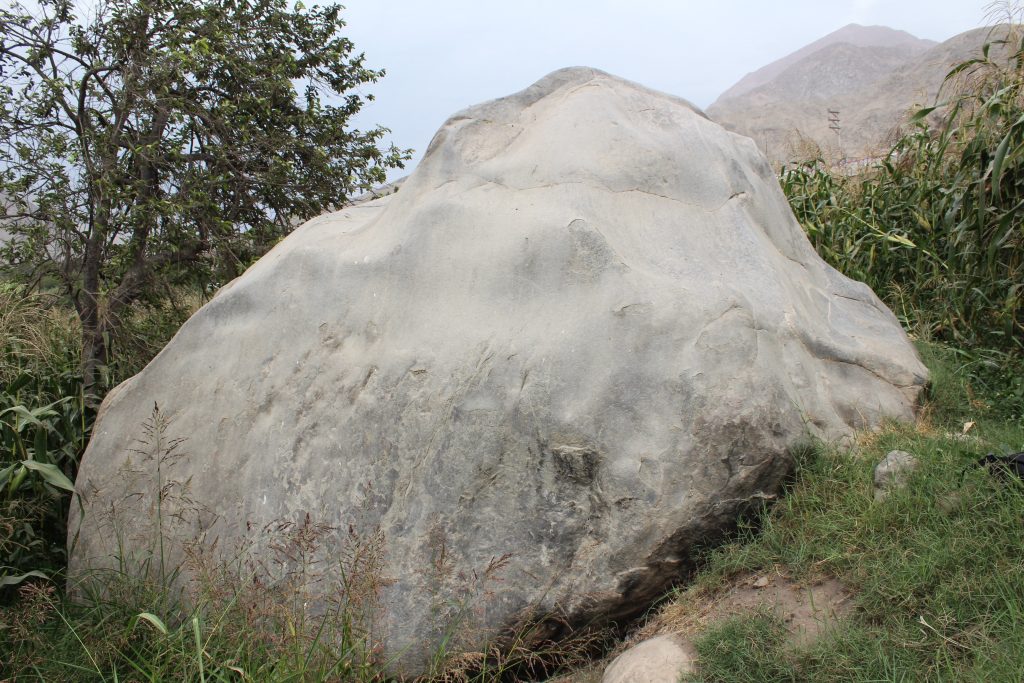
Leon, the guide and organiser of the exhibits is a trim sixty year old in a green t-shirt, with short white hair and a tanned, lined face.
“We opened yesterday”, he tells me. “We have rented this hall for six weeks. After that we will have to move.”
He takes me through the formation of the earth and the rise and fall of the dinosaurs before arriving at what is clearly his personal enthusiasm – fossilised whales.
These lived in and around what was once a coastal or inland sea, and is now the low lying Occucaje desert, 40 km wide and 120 km long.
This desert just 150 km to the south of Lunahuana is the world’s greatest marine fossil site, he tells me. Whales and sharks, crocodiles and turtles, evolved here in shallow seas over tens of millions of years.
“The land was flooded time after time. Whenever there was global warming, and the sea level rose, it flooded the area, and here we find fossils of whales and sharks, not just a few bones, but complete skeletons.”
The fossils include whales with a single line of teeth down the centre of the palate, whales with hundreds of teeth not in a line but in a grid, like a crushing machine, and the very first whales, who had no teeth at all but bare bone, an extension of the skull, shaped to make a pair of scissors between the upper and lower jaw.
“They found a whale with four legs recently in Ocucaje” he tells me with excitement. “they are now examining it. They have nearly finished all the body, they just have to study the head.”
The birthing pool of the first mammals to return to the water, evolving into the sea creatures like dolphins and whales, was thought to be the shallow seas of India. Here they have identified in the fossil record a four legged land animal that was also equipped with bones to hear under water, and have followed it through various stages from four legged swimmers with hip bones to sea based creatures with front flippers and vestigial back legs.
To find this evolution taking place, perhaps in parallel, in the ancient seas of present South America would be a remarkable moment in science.
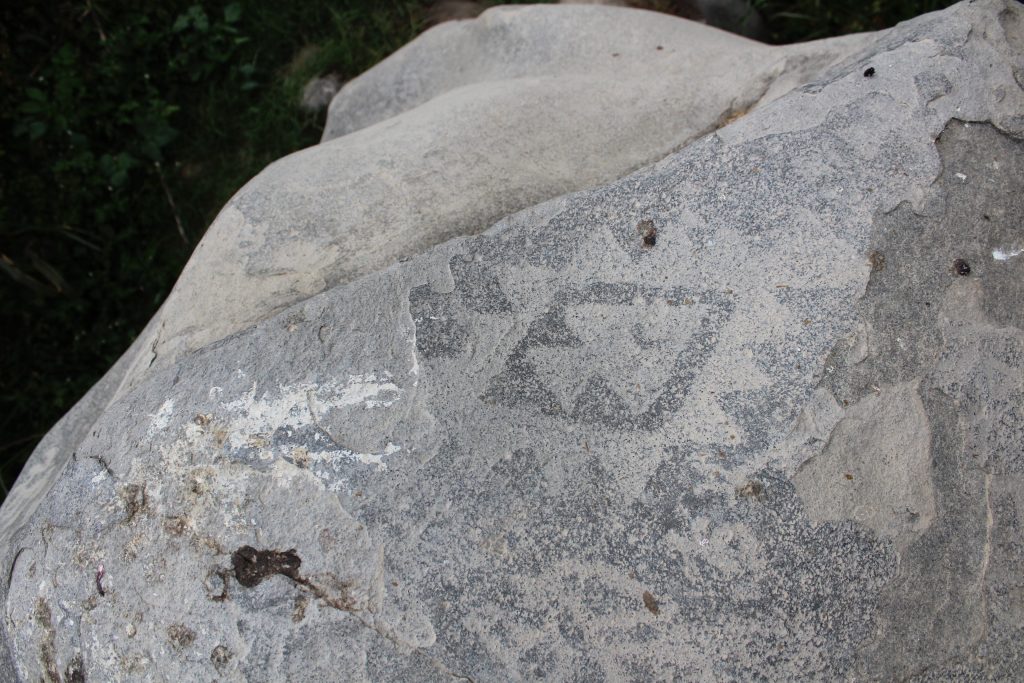
“I have seen some ceramics, from the Nazcas, that show a whale with four legs,” he tells me, “and I wonder if they got the idea from fossils”.
One of the main Nazca deities, or more correctly anthropomorphic beings, is the Mythical Killer Whale. This beast has an arm or hands holding a trophy head.
“I wonder – it is just an idea – if they could have seen something like this in the desert…”
At the end of the line of exhibits are two glass cases with local archaeological findings. Martin, a local tour operator, is registering and extending the collection. “I want to at least record these things. People keep them in their houses, objects they have dug up in the fields.”
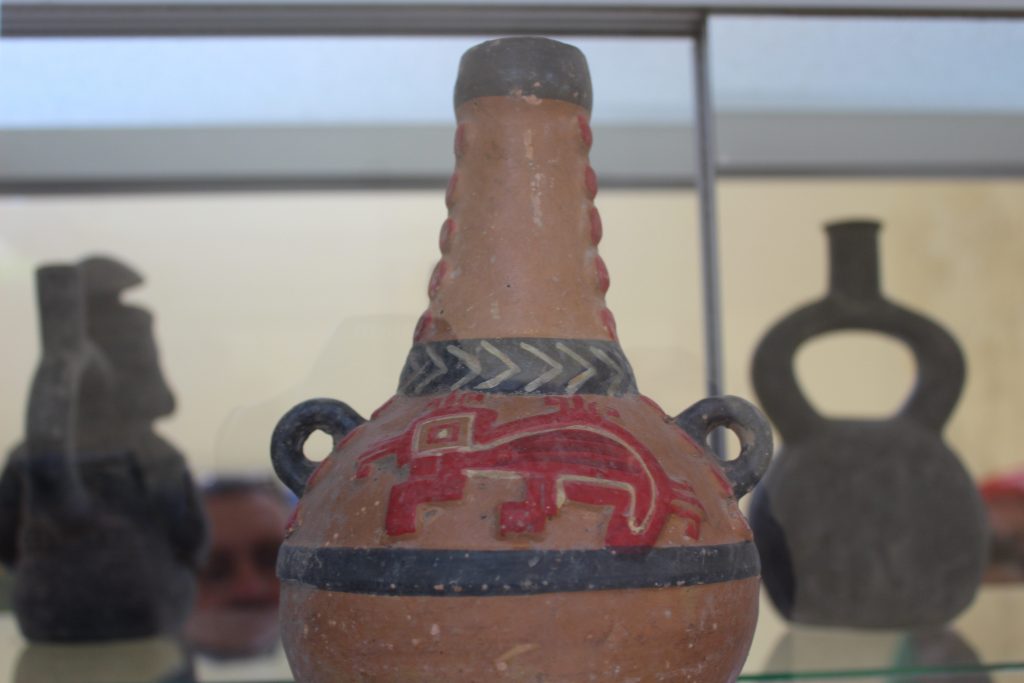

The cabinets hold some pottery fragments, a finely woven dark red sash, Inca style, and a woven purse, with embroidered decorations in dark llama hair. There is a mummified baby, wrapped in a shroud and placed in a woven basket. “We found it in a trash can,” Martin says.
He has been going door to door, asking people to at least register their personal collection, and better still donate it for central display.
“But we only have this hall for a few weeks. After that we will have to move.”
Martin speaks with the simple patience of someone with considerable experience of dealing with indifference if not outright hostility.
“I spoke to the Mayor about finding a permanent place to display, but he told me he wasn’t interested.”
There are some large pots, in pieces, one with the legs and tail of a feline style figure, another with a line of crenellations like those marked on the stone. “This is our local Guarco pottery, before the Incas.” One almost complete pot has a fine raised figure, a porcupine, Martin says. It has the same geometric style as the creature on the stone.
“When the Incas came, all these fine works stopped. Everything became very simple, functional. The keros, the beakers, the textiles were just repeated simple squares, the ceramics simple black and red designs. After the Incas took over, nobody had time to make art.”
I tell him that I am studying the images on the piedra sagrada, the sacred stone, and have found some minor images on other stones in the field. Were there any more engravings in the valley?
“There are many more stones,” Martin says, “but it is difficult to find them, they are on private land.”
“Perhaps someone from the town could show me?”
“Everyone is busy now with the tourists. Come back at four.”
This is Easter Sunday, the town’s busiest day of the year. The Plaza de Armas, the main square, holds a thousand people. On one side kiosks sell cocktails made on a pisco base, with lime, mint, maracuya, or fresa, strawberries.
All these people are ordering cocktails, recovering from their rappelling or their zip-lining over the stormy waters of the river, and wondering what to do next. Not visiting the palaeontology museum, that is for sure.
I return at four and Martin and Leon are sitting on benches in front of the hall.
“People have been walking past and asking, and when I say there is a 5 soles entry fee they walk on by.”
“So how about showing him the stones?” says Leon.
Martin shrugs. “Are you ready? Lets go.”
We walk through the town and down the steps to the canoe landing stage. Hundreds of people crowd the river bank, eating ice creams and chicken and chips in polystyrene containers.
We cut left through the camp site, climb a low wall and walk across the field to the stone at its centre.
“The people here were the Guana or Huana”, says Martin, as we look at the multiple images of birds on the rock. “Lunahuana or more correctly Runa Huanac means the people of the Huanac which is a sea bird. I have always thought that these bird images are the emblems of the people, they are writing their name on the rock.”
“We are nearly 40 kilometres from the coast. Are they not a long way inland to choose a sea bird as their emblem?”
“I understand they were called the Guana people because they used the droppings of the Guanay Cormorant to fertilise their crops. They would collect it in large quantities from deposits on islands offshore.”
“Guano! We used it to fertilise the British farms too, in the nineteenth century.”
“Indeed. Guano was very valuable. From the 1840s onwards Peru borrowed funds in London with its guano resources as security. The US were furious because they could not get their hands on more guano – it was all tied up in debt obligations. In 1864 the Spanish seized the guano islands off Chincha, using as a pretext a drunken fight in the provinces where one Spaniard was killed. And then in 1879 you gave Chile the weapons and money to overcome us in the War of the Pacific, which was fought over control of nitrate deposits in the Atacama desert.”
“That’s quite a story. So that explains the bird images. What else might there be here?”
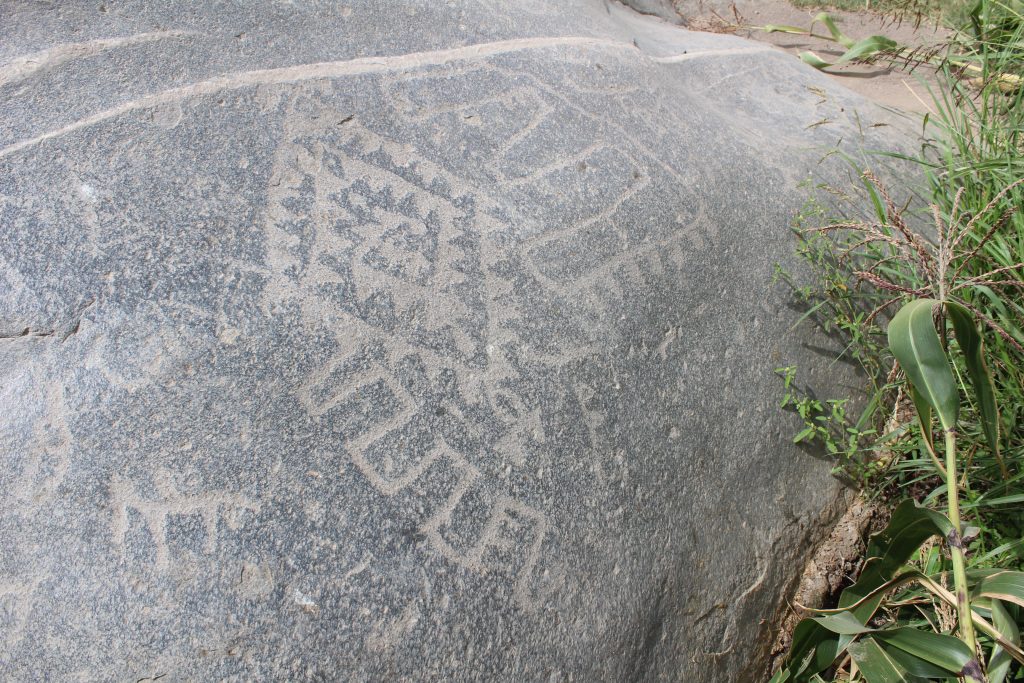
“I used to play here as a boy,” Martin says. “So many years ago. I remember there was a monkey. I would like to find it again.”
We pass the great stone and circle several boulders low down to the ground, partially covered in earth and burnt maize stalks. I have already looked at these the previous afternoon and seen nothing. But this time, on a large flat stone by the edge of the field, I see a tidy little rectilinear llama figure, low down on one side.
We clamber over a wall into the next strip of land. Here there are low fruit trees and vines. Narrow furrows run between each line of trees, leading down and across from the irrigation canal at the upper end, with water running in the channels and winding round to irrigate the whole area.
After crossing several more narrow fields we find ourselves amongst small fruit trees with pathways leading to a guanaba tree. Beneath the tree is a smooth faced rock, in the shadows, and when the light falls at a certain angle on the stone, I can just distinguish a line of four or five marching llamas. There are initials underneath drawn in an archaic style, and on the upper surface, a cross or a sword.
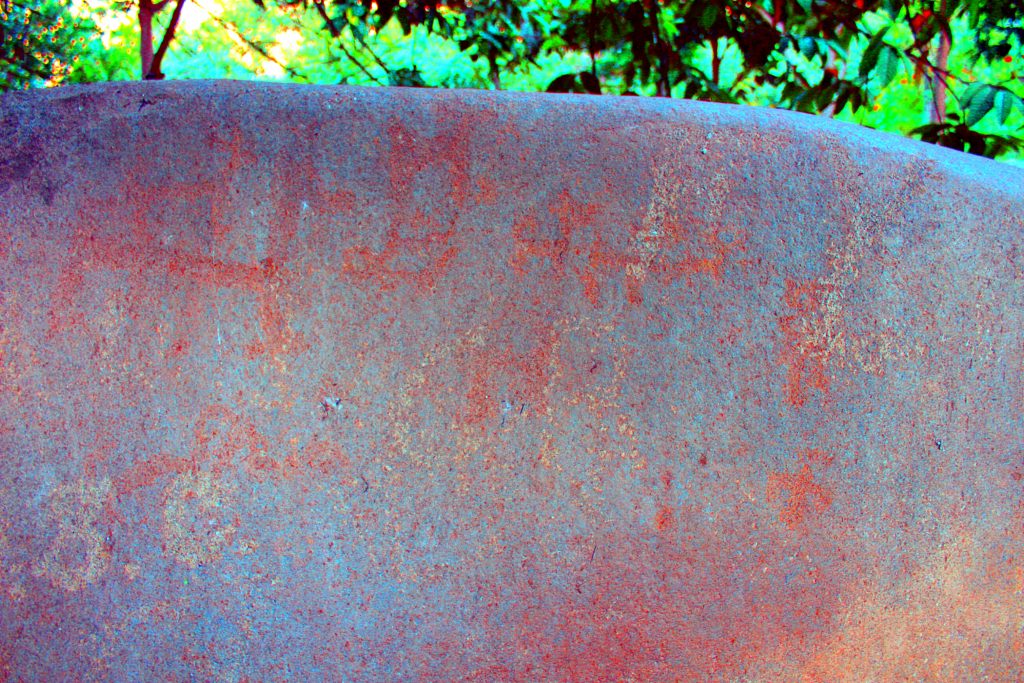
We return along the river bank close to the water’s edge, and climb over the wall to the first field. A flat topped rock projecting from the a cultivation terrace close to the wall shows some faint markings on its leading edge. There is no colour change, but by viewing in the reflected light of the low sun we can make out a finely traced figure. “This is it!” Martin laughs, “this is my monkey!”
I am not sure if it represents a monkey, but it has a strange crest on its head that I have seen somewhere before.
*********************************************
Later, I sit in the Plaza under the trees in the warm night, sipping a mojito, rum, lime and mint, that was mixed for me at one of the cocktail stalls arranged around the square, and I watch the crowds walk by. My phone rings.
“It’s Mayra. I’m coming back.”
“How are you? What is going on? Where are you?”
“I am still in Caracas. But I am bringing my little sister out. My parents will not leave.”
“So . . . what happened?”
” I don’t want to talk about it now. I will tell you soon. Let’s meet up. Get out of town. I want to walk in the fields again.”
“When will you be back?”
“In a week, maybe two. Don’t worry. I will see you soon.”

